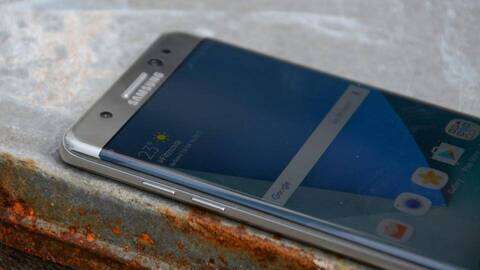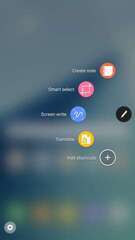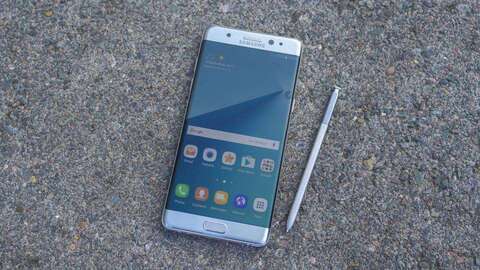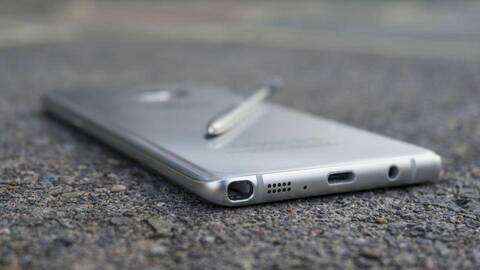Samsung Galaxy Note 7 Samsung Galaxy Note 7 review: Samsung's exploding phablet
Ah, Samsung's Galaxy Note 7. No other phone is as notoriously infamous as the plus-sized explodey phone. Following a spate of battery defects, with countless reports of phones erupting into flames, and in some cases exploding, the Note 7 was swiftly pulled from store shelves mere weeks from release. It was also banned from flights, do you remember that?
Well, thankfully, Samsung has managed to pull itself together in the two years that followed, successfully keeping the Note name alive. The exploding phablets of the past are now just a distant, faded memory and we've since seen two excellent Note 7 follow-ups.
Still, we're here for the Note 7 and you can read Katharine's original review below, which was written in the few days before the Note 7 battery debacle. Ignorance is bliss and all that.
Samsung Galaxy Note 7 review: Design
Having skipped the Note 6 to bring it in line with this year's Galaxy S7 range, the Note 7 takes everything we know and love from Samsung's smaller flagship handsets and improves upon them in almost every way, making it arguably one of the most practical phones on the planet.

Its trademark S Pen stylus is probably the main reason why you'd choose this over Samsung's slightly smaller Galaxy S7 Edge , but the Note 7 also comes with water resistance (up to 1.5m of fresh water for 30 minutes), a microSD slot to expand its already-quite-sizable 64GB of internal storage up to 256GB, extra security from its fingerprint and iris-scanner combination, a colossal 3,500mAh battery and a gorgeous curved edge display.
Despite measuring 7.9mm at its thinnest point, the Note 7 feels like a chunky slab of technology. This isn't necessarily a bad thing. The combination of its curved display and gently rounded sides make it more comfortable to hold than the more angular S7 Edge.
It's a shame its glossy front and rear attract fingerprints so readily, but this has been a recurring theme with Samsung's smartphones ever since it decided to follow in Sony's footsteps and use glass on both the front and back. Fingerprints aside, it’s a stunning phone, and its metal frame adds that extra touch of class you expect from such a high-end handset.
Samsung Galaxy Note 7 review: Stylus
The stylus is tucked away on the bottom-right corner. It's spring-loaded, so you'll need to push in to release it from its little cubby hole and click it home when you replace it. The phone vibrates when you take it out, too, so you always know when it's not secure, and an alarm will sound if you accidentally leave it behind.

As with previous Note devices, removing the pen conjures up Samsung's Air Command wheel on the screen. You can swap these out for up to six apps of your own, but the default S Pen features do have their uses. Smart Select and Screen Write can crop or annotate what's currently onscreen, while Translate – arguably the best new S Pen feature – will translate text for you.
Simply select your source and target language, and hover the pen over the word in question. Admittedly, not all source languages are currently supported at the moment – Japanese and Chinese were notably absent at time of writing, for example – but hopefully Samsung will keep adding new languages with future software updates.
Meanwhile, Magnify uses the stylus' current position to enlarge a portion of the screen up to 300% to make it more legible, and Glance is the lazy man's answer to the Recent Apps button. This creates a small thumbnail of the app you're currently using so that you can flick between two different things very quickly. It's a fraction more convenient than tapping the Recents button, but if you really need to constantly switch between different apps, you'd probably be better off using Samsung's Split View feature and having both apps open side by side.
Glance aside, most of the dedicated S Pen apps do make good use of the stylus, and the pen itself is brilliant for jotting down the odd scribble. With 4,096 levels of pressure sensitivity, it picks up every pen stroke almost instantaneously, making it feel very quick and responsive. What's more, the screen has built-in palm rejection, so you can rest your hand on the screen while you write. There's no other phone that does this so well, so if the idea of having a portable notebook in your pocket sounds appealing, the Note 7 certainly won't disappoint.

Samsung Galaxy Note 7 review: Display
Another big draw of the Note 7 is its huge 5.7in Super AMOLED display. Its resolution of 2,560 x 1,440 might give it a coarser pixel density of 515ppi compared to its S7 cousins – which pack the same resolution into smaller 5.1in and 5.5in screens – but the difference in sharpness wasn’t visible to my eyes when I compared them side by side.
As I've come to expect from Samsung's Super AMOLED technology, image quality on the Note 7 is excellent. The screen covers a full 100% of the sRGB colour gamut, and its pure 0.00cd/m2 black levels ensure text remains dark and inky when you're browsing the web or reading a book. Likewise, with effectively perfect contrast, images have plenty of detail and viewing angles are excellent.

The Note 7's automatic brightness has also received a significant boost in quality, as it now has an ambient light sensor on both the front and back of the handset. This allows it to set the screen brightness more accurately than other phones that only have a sensor on the front, but that's not all, as the Note 7's automatic brightness is also able to reach much higher levels than any other phone I've tested.
Like Samsung's other flagship phones, the automatic brightness works by allowing the screen to go into a kind of “overdrive” mode in really high ambient-light conditions, boosting the brightness above normal levels when you're in direct sunlight, for example. I tested this by shining a bright torch directly at the phone’s front and rear light sensors.
Under these circumstances, the screen's peak brightness jumped from its usual maximum of 363cd/m2 (the maximum when in manual brightness mode) right up to 872cd/m2, which is an incredible result for this type of screen technology. This is extremely handy when you're outdoors and need that extra boost to combat glare, and it makes it much more versatile than other AMOLED displays.
The Always On Display makes a welcome return as well, allowing you to see the time, date and notification icons onscreen even when the phone is locked or in sleep mode. This is useful if all you want to do is find out the time, and it doesn't use a lot of battery, either: Samsung's Super AMOLED screen technology only illuminates the pixels it needs rather than the entire backlight like IPS-based displays. Of course, those curved edges also mean also get all of Samsung's additional Edge Screens. These are activated by a simple thumb swipe on the small translucent tab on the side of the screen.
Admittedly, I never found the Apps Edge, which lists up to two rows of additional shortcuts, particularly useful. I found it quicker for me to just swipe to their location on the home page. The People Edge is a bit more practical, providing instant access to your most-used contacts, allowing you to call, text and email them with a couple of taps. However, while you can also place similar shortcut widgets directly on the homescreen, it makes you wonder whether the Edge Screens really make things more convenient. It can be a little awkward to wrap your fingers around it when you’re holding it in just one hand.
Samsung Galaxy Note 7 review: Iris scanner
In addition to the front-facing fingerprint reader, the Note 7 also comes with an iris scanner. This is arguably more secure than a fingerprint reader, as no-one can replicate your own eyes, and the unlocking procedure doesn't leave any marks on the phone – unlike your mucky fingerprints. It's surprisingly quick once it locks on, too, with the whole process taking only a couple of seconds.
It warns you during the initial setup that people who wear glasses or contacts might have trouble using it, but as a contact-lens wearer myself, it only failed to recognise me twice throughout my entire testing period. Tests on a glasses-wearing colleague were less successful, with the scanner failing roughly 50% of the time.